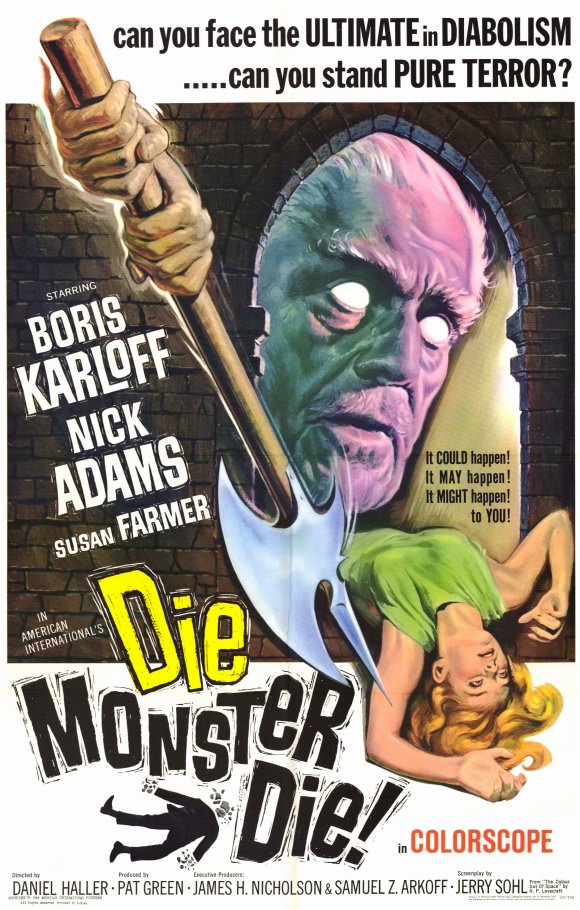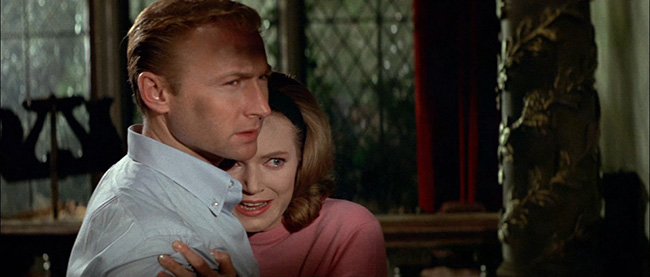
In the evening I asked old people in Arkham about the blasted heath, and what was meant by that phrase “strange days” which so many evasively muttered. I could not, however, get any good answers, except that all the mystery was much more recent than I had dreamed.
-H.P. Lovecraft, “The Colour Out of Space”
Die, Monster, Die! (1965), based on H.P. Lovecraft’s 1927 story “The Colour Out of Space,” is one of a handful of Lovecraft adaptations produced by American International Pictures, who were otherwise focused, as far as horror was concerned, on the work of Edgar Allan Poe. Previously, AIP had delivered a Lovecraft adaptation under a title borrowed from Poe: The Haunted Palace (1963), starring Vincent Price and based (very loosely) upon Lovecraft’s novel The Case of Charles Dexter Ward. After 1965’s Die, Monster, Die! with Boris Karloff, AIP would revisit Lovecraft with another Karloff film, The Crimson Cult (1968, inspired – again, loosely – by “Dreams in the Witch-House”), followed by the superior The Dunwich Horror (1970 – now available from Blu-Ray from Shout! Factory). The latter film was directed by Daniel Haller, the virtuoso, Corman-approved art director behind such Gothic AIP classics as Pit and the Pendulum (1961), Tales of Terror (1962), and The Raven (1963), along with A Bucket of Blood (1959), The Little Shop of Horrors (1960), X: The Man with the X-Ray Eyes (1963), and The Haunted Palace. Die, Monster, Die! marked his directorial debut, and he chose an appropriate subject. By diving into the surreal world of Lovecraftian horror, he was giving himself the opportunity to play with colorful camera tricks, decrepitude, and psychedelia.
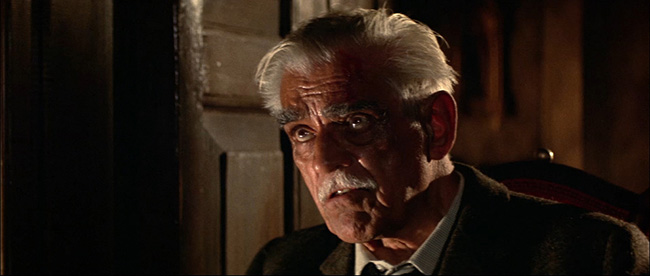
Boris Karloff as Nahum Witley.
But as a Lovecraft adaptation, it’s a mixed bag. The film was shot in England, where Karloff lived (next door to Christopher Lee), with a largely British cast and crew: therefore, Arkham, New England, becomes Arkham, England. Although the bones of the film are Lovecraft’s, additional elements, to pad out the running time, come straight from the AIP stock Gothic department: Karloff’s Nahum Witley lives in an isolated, fog-enshrouded manor house occupied by cobwebs, creepy (silly) family portraits, and secret chambers. In the mid-60’s, genre fans knew Lovecraft, but he wasn’t widely known to commercial audiences. (Amazingly, even on the 2015 Shout! Factory Blu-Ray, the label doesn’t drop the name Lovecraft into the film summary – which would surely be a selling point in this era of Lovecraft-branded everything.) Yet the film doesn’t shrug off the original story, either; at one point, our hero pages through an old volume called Cult of the Outer Ones, and we do glimpse some mutated humans which are very Lovecraftian in design. Nonetheless, it would not be until The Dunwich Horror that Haller would have license to fully embrace the world of the author; by that point – post-Rosemary’s Baby – the Corman style of Gothics were out of fashion. Die, Monster, Die! also has a Hammer horror feel, and not just because it was shot in England with a vibrant color scheme. The charming lead actress, Suzan Farmer, would soon be starring in Dracula: Prince of Darkness (1966) and Rasputin: The Mad Monk (1966). Also present is Freda Jackson, from Brides of Dracula (1960) and The Shadow of the Cat (1961). In smaller roles are Sydney Bromley (Horrors of the Black Museum, Night Creatures, Paranoiac, Slave Girls, The Fearless Vampire Killers) and the prolific British character actor Patrick Magee, best known for A Clockwork Orange (1971), but who also appeared in Hammer’s interesting Demons of the Mind (1971). The one element jarringly out of place is, alas, the lead actor, Nick Adams, the American star of the TV series The Rebel, whose style of acting is from the James Dean school (Dean was his friend) – nothing wrong with that, but it has no place in this kind of film. At one point he’s raging with such anguish at Karloff that it’s easy for your sympathies to switch from the hero to the villain.
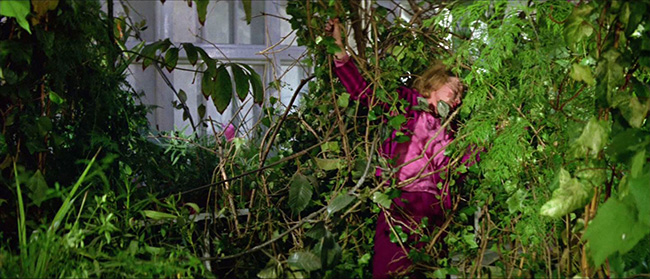
Susan Witley (Suzan Farmer) is attacked by vegetation in her father’s greenhouse.
Adams, who looks and dresses like an American Tintin, plays Stephen Reinhart, a college friend of Susan Witley (Farmer), invited to Arkham by her ailing mother Letitia (Jackson). On the way to the Witley House he encounters a crater in the earth, and surrounding the area, nothing grows. In the manor he encounters Nahum Witley, who urges Stephen to leave, but is overruled by his wife, as well as the ecstatic Susan, who doesn’t waste time making out with Stephen. Nahum and his servant Merwyn (Terence de Marnay, Confessions of an Opium Eater), who wears blue-tinted spectacles, guard a secret which has something to do with the crater near the manor, the pulsing green light coming from the Witleys’ greenhouse, Mrs. Witley’s illness, and a green-glowing rock surrounded by images of skulls and demons in the catacombs of the home. Adding to the strangeness: a shadowy, veiled figure who keeps popping up at windows, a la The Innocents (1961), but who proves to be very real, at one point attacking Reinhart with a knife. When Reinhart finally breaks into the greenhouse with Susan at his side, he encounters giant plants and tomatoes, and a room which he describes as “a zoo in Hell” – Haller’s team doing the best they can to create Lovecraftian horrors using 1965 special effects. (It’s fine. And fun.) Reinhart realizes the plants and mutations are caused by little green rocks, which have an effect even more potent than uranium. Susan is attacked by living plants in the greenhouse, like something out of the same year’s The Day of the Triffids. Reinhart also breaks into the secret chamber beneath the Witley House, where he finds a giant, green-glowing rock, which has been transforming – or, rather, melting – Mrs. Witley, and already turned her nurse – the veiled woman – into a mutant psychopath. In the final transformation caused by the cosmic rock, Karloff becomes a hulking silvery monster.
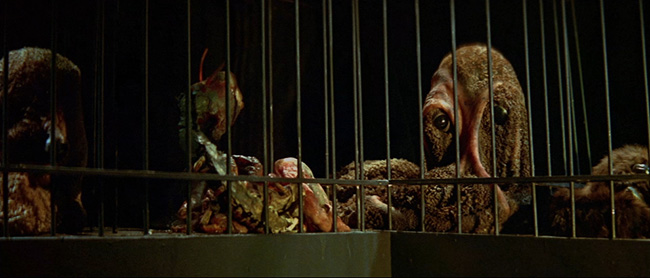
The things in the greenhouse.
With all this incident packed into one film, Die, Monster, Die! certainly sounds exciting, but it still doesn’t quite fill out its 80 minute running time; the film can drag if you don’t fall into its languid spell. I took to it more on this second viewing, when I was aware of its flaws going in. One key problem is that the padded elements feel out of place. These include the axe-wielding nurse whose face is melting, and references to rituals to the “Outer Ones,” as performed by Nahum’s father Corbin Witley, who “went insane.” There’s no need for any rituals in the plot, really, as much as one might want to squeeze in the Necronomicon. A straightforward telling of the corruption of a small village by an alien poison from outer space, as in Lovecraft’s original, would make for a more interesting, and cohesive, story. Nonetheless, the film has so much that’s outré, and such a rich atmosphere thanks to Haller’s gifts, that it remains a notable installment of AIP’s 60’s horror. Karloff, whose health was failing, is as committed as ever to his performance, even though there’s nothing much that really separates Nahum Witley from the prior decades’ worth of creepy old men with secrets living in Old Dark Houses. There’s a particular, unexpected integrity in Die, Monster, Die! Haller knew the worth of Lovecraftian horror, even though, in this early film adaptation, the author’s interest in the terrifying unknowable doesn’t perfectly fit into the 60’s AIP brand, where the genre elements were often cookie-cutter.
